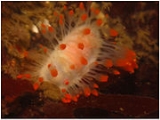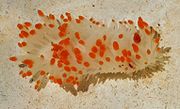
Limacia cockerelli
Encyclopedia
Limacia cockerelli is a species
of sea slug
, a dorid nudibranch
, a shell-less marine
gastropod mollusk in the family Polyceridae
.
ranging from Vancouver Island
, British Columbia
, Canada
to Baja California
. It has also been found in the Gulf of California
at Bahía de los Ángeles
.

have tubercles that are slightly longer and tipped with orange. Intermediate forms exist in central and northern California. Another form in California has large red blotches on the dorsum. The eggs of the Limacia cockerelli are pink and develop after 17 days, (at 10-13 degrees C), into hatching planktotrophic veliger
s.
Species
In biology, a species is one of the basic units of biological classification and a taxonomic rank. A species is often defined as a group of organisms capable of interbreeding and producing fertile offspring. While in many cases this definition is adequate, more precise or differing measures are...
of sea slug
Slug
Slug is a common name that is normally applied to any gastropod mollusc that lacks a shell, has a very reduced shell, or has a small internal shell...
, a dorid nudibranch
Nudibranch
A nudibranch is a member of what is now a taxonomic clade, and what was previously a suborder, of soft-bodied, marine gastropod mollusks which shed their shell after their larval stage. They are noted for their often extraordinary colors and striking forms...
, a shell-less marine
Marine (ocean)
Marine is an umbrella term. As an adjective it is usually applicable to things relating to the sea or ocean, such as marine biology, marine ecology and marine geology...
gastropod mollusk in the family Polyceridae
Polyceridae
Polyceridae is a taxonomic family of sea slugs, dorid nudibranchs, marine gastropod mollusks within the Superfamily Polyceroidea.- Taxonomy :...
.
Distribution
This species is found from the West coast of North AmericaNorth America
North America is a continent wholly within the Northern Hemisphere and almost wholly within the Western Hemisphere. It is also considered a northern subcontinent of the Americas...
ranging from Vancouver Island
Vancouver Island
Vancouver Island is a large island in British Columbia, Canada. It is one of several North American locations named after George Vancouver, the British Royal Navy officer who explored the Pacific Northwest coast of North America between 1791 and 1794...
, British Columbia
British Columbia
British Columbia is the westernmost of Canada's provinces and is known for its natural beauty, as reflected in its Latin motto, Splendor sine occasu . Its name was chosen by Queen Victoria in 1858...
, Canada
Canada
Canada is a North American country consisting of ten provinces and three territories. Located in the northern part of the continent, it extends from the Atlantic Ocean in the east to the Pacific Ocean in the west, and northward into the Arctic Ocean...
to Baja California
Baja California
Baja California officially Estado Libre y Soberano de Baja California is one of the 31 states which, with the Federal District, comprise the 32 Federal Entities of Mexico. It is both the northernmost and westernmost state of Mexico. Before becoming a state in 1953, the area was known as the North...
. It has also been found in the Gulf of California
Gulf of California
The Gulf of California is a body of water that separates the Baja California Peninsula from the Mexican mainland...
at Bahía de los Ángeles
Bahía de los Ángeles
' is a coastal bay on the Sea of Cortez, located along the eastern shore of the Baja California Peninsula in the state of Baja California, Mexico...
.

Description
This species reaches lengths of 26 mm. It has long dorsal papillae with white branchial plumes. It is found in two forms. The northern form has white tubercles down the middle of the dorsum. The second form, found in areas south of Point ConceptionPoint Conception
Point Conception is a headland along the Pacific coast of U.S. state of California, located in southwestern Santa Barbara County. It is the point where the Santa Barbara Channel meets the Pacific Ocean, and as the corner between the mostly north-south trending portion of coast to the north and the...
have tubercles that are slightly longer and tipped with orange. Intermediate forms exist in central and northern California. Another form in California has large red blotches on the dorsum. The eggs of the Limacia cockerelli are pink and develop after 17 days, (at 10-13 degrees C), into hatching planktotrophic veliger
Veliger
A veliger is the planktonic larva of many kinds of marine and freshwater gastropod molluscs, as well as most bivalve mollusks.- Description :...
s.
Diet
This animal preys exclusively on the orange-brown colored bryozoans, Hincksina velata and Membranopora.Further reading
- Vallès, Y.; Valdés, A.; Ortea, J. 2000. On the phanerobranch dorids of Angola (Mollusca, Nudibranchia): A crossroads of temperate and tropical species. Zoosystema, 22(1): 15-31.
- Behrens, D.W. (1991) Pacific Coast Nudibranchs. Sea Challengers: Monterey, California.
- Goddard, J.H.R. 1984. The opisthobranchs of Cape Arago, Oregon, with notes on their biology and a summary of benthic opisthobranchs known from Oregon. The Veliger, 27(2): 143-163.
- Goddard, J.H.R. (1987) Observations on the opisthobranch mollusks of Punta Gorda, California, with notes on the distribution and biology of Crimora coneja. The Veliger, 29(3): 267-273.
- Goddard, J.H.R. (1998) A summary of the prey of nudibranch molluscs from Cape Arago, Oregon. Opisthobranch Newsletter, 24: 11-14.
- McDonald, G.W. (1983) A review of the nudibranchs of the California coast. Malacologia, 24: 114-276.
- McDonald, G.R. & Nybakken, J.W. (1978) Additional notes on the food of some California nudibranchs with a summary of known food habits of California species. The Veliger, 21(1): 110-119.
- Vallès, Y.; Valdés, A.; Ortea, J. 2000. On the phanerobranch dorids of Angola (Mollusca, Nudibranchia): A crossroads of temperate and tropical species. Zoosystema, 22(1): 15-31.

